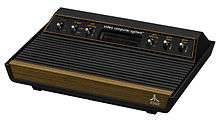Imagic
Imagic (/ɪˈmædʒɪk/ i-MA-jik) was an American video game developer and publisher that created games initially for the Atari 2600. Founded in 1981 by Atari, Inc. and Mattel expatriates, its best-selling titles were Atlantis, Cosmic Ark, and Demon Attack.[1] Imagic also released games for Intellivision, ColecoVision, Atari 8-bit family, TI-99/4A, IBM PCjr, VIC-20, Commodore 64, and Magnavox Odyssey². Their Odyssey² ports of Demon Attack and Atlantis were the only third party releases for that system in America. The company never recovered from the North American video game crash of 1983 and was liquidated in 1986.
| Private | |
| Industry | Video games |
| Fate | Liquidation |
| Founded | 1981 |
| Defunct | 1986 |
| Headquarters | , |
Key people | Bill Grubb Dennis Koble Bob Smith Rob Fulop |
History
Imagic was the second third party publisher for the Atari 2600, formed after Activision.[2] Founders included Bill Grubb, Bob Smith, Mark Bradley, Rob Fulop, and Denis Koble from Atari, Inc.,[3] Jim Goldberger, Dave Durran and Brian Dougherty from Mattel,[4] as well as Pat Ransil from Intel and Gary Kato from Versatec. Grubb left an 18-month post at Atari as a vice president of marketing[5] to form Imagic. Before that, he was with the marketing department at Black and Decker for 11 years.[6] It was Grubb's goal to take Imagic public[7] and to eventually overtake Activision as the number one third party video game publisher.[6]
Atari sued Imagic over Demon Attack because of its resemblance to Phoenix,[8] to which Atari had the exclusive home-version rights. The case was settled out of court.
Despite initial success and sales greater than projections, the company's fortunes reversed after the stock market dumped videogame stocks in late 1982, scuttling Imagic's initial plan to become a publicly traded company.[9]
Fan club
During its height, Imagic ran a fan club for their games, the Numb Thumb Club, which published an annual newsletter.[10] Only two issues were published before Imagic's demise in 1983.[10]
Decline
Although Imagic grew quickly in its early years, it was irreparably harmed by the video game crash of 1983. It released 24 titles before going out of business by 1986, but the exact time it disbanded is unknown. In 1983 the company laid off 40 of their 170 employees[11] but appeared at the 1984 Consumer Electronics Show with plans for four IBM PCjr games.[12] The rights to Imagic's most popular titles have been owned by Activision since the late 1980s, and they have been re-released on several occasions.
Games
Imagic 2600 cartridges were distinct from both Activision and Atari cartridges with an extended ridge at the top of the cart. Packaging was distinctive due to the use of reflective silver on the boxes. The years are for the original versions only, not subsequent ports.
1982
- Atlantis
- Cosmic Ark
- Demon Attack
- Dracula
- Dragonfire
- Fire Fighter
- Beauty and the Beast
- Microsurgeon
- Riddle of the Sphinx
- Swords & Serpents[13]
- Star Voyager
- Trick Shot
1983
- Fathom
- Ice Trek
- Laser Gates
- Moonsweeper[14]
- No Escape!
- Nova Blast
- Quick Step
- Safecracker
- Shootin' Gallery
- Tropical Trouble
- Truckin'
- White Water!
- Star Wars: The Arcade Game
1984
- Chopper Hunt, formerly Buried Bucks from ANALOG Software
- Tournament Tennis
- Wing War
Unreleased
Cubicolor, a two-player puzzle game loosely based on a combination of a Rubik's Cube and fifteen puzzle, that was completed but never officially released before Imagic's demise. Approximately 60 cartridges exist and most are signed and numbered by the original programmer, Rob Fulop.
References
- "Demon Attack". Atari Age. Archived from the original on 2012-10-15. Retrieved 2007-04-09.
- "Classic Gaming Expo Distinguished Guest: Alan Miller". Classic Gaming Expo. Archived from the original on February 8, 2012. Retrieved 2006-08-30.
- "Playing Catch Up: Night Trap's Rob Fulop". Gamasutra. CMP. Retrieved 2007-04-09.
- "Archived copy". Archived from the original on 2007-05-24. Retrieved 2007-07-04.CS1 maint: archived copy as title (link)
- Hayes, Thomas C. "Imagic Scores in Video Games". The New York Times. Retrieved 29 January 2014.
- "Video Games Interview: Bill Grubb and Dennis Koble". Video Games Magazine. Atari HQ. Retrieved 29 January 2014.
- "All in the Game - Imagic: The Making of Atlantis". Enterprise. PBS. Retrieved 29 January 2014.
- "Demon Attack: This game is pure Imagic!". Atari Times. Retrieved 2007-04-10.
- http://www.livevideo.com/video/151AF95D9F4D4AD0B23A7123E2B65C0C/making-of-atlantis-video-game-part-3-imagic.aspx
- "Imagic Titles for Intellivision". Intellivision Lives. Intellivision Productions. Archived from the original on 2006-12-08. Retrieved 2007-04-09.
- "Imagic Layoffs".
- Cook, Karen (1984-03-06). "Jr. Sneaks PC into Home". PC Magazine. p. 35. Retrieved 24 October 2013.
- "Intellivision Classic Video Game System / Imagic for Intellivision". www.intellivisionlives.com.
- Holyoak, Craig (1984-05-30). "Here are ColecoVision's jewels". Deseret News. pp. 4 WV. Retrieved 10 January 2015.
